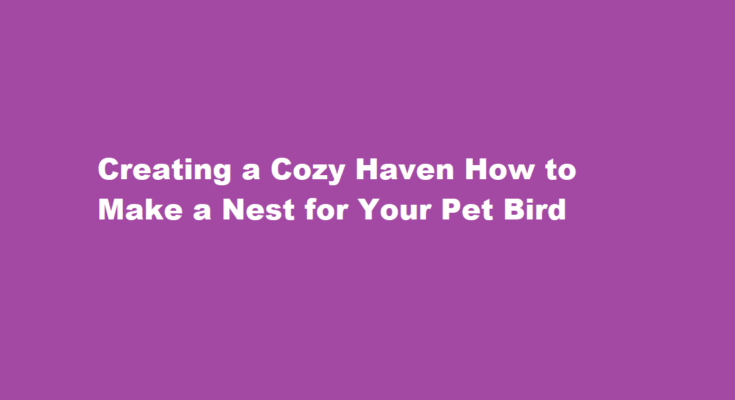Introduction
Pet birds bring joy, companionship, and vibrant energy into our lives. To ensure their well-being and happiness, it’s essential to provide them with a comfortable and secure nesting space. Crafting a nest for your feathered friend is an art that can enhance their quality of life. In this article, we will guide you through the steps of creating a cozy haven for your pet bird, offering them a safe retreat and a place to flourish.
Choose the Right Nesting Material
The first step in creating a comfortable nest for your pet bird is selecting the right nesting material. Birds have varying preferences, so it’s crucial to consider your bird’s species. Common nesting materials include
- Twigs and branches
- Leaves and grass
- Soft materials like shredded paper or cotton
- Coconut fibers or straw
Research your bird’s natural habitat to mimic it as closely as possible. For example, finches prefer soft materials, while budgerigars may enjoy twigs and branches. Ensure that the materials are clean, free of pesticides, and safe for your bird to use.
Provide a Suitable Nesting Box
A nesting box provides a secure and private space for your pet bird to lay eggs and raise chicks, if applicable. The size and design of the nesting box should align with the bird’s species. Some general guidelines for selecting or building a nesting box include
- Adequate size – The box should be spacious enough for the bird to move comfortably, but not too large to feel insecure.
- Proper ventilation – Ensure good airflow to prevent moisture buildup and fungal growth.
- An accessible entrance – The entrance hole should be appropriately sized for the bird to enter and exit comfortably.
- A removable lid or side – This allows for easy access for cleaning and inspection.
Always place the nesting box in a quiet and secluded area of the cage or aviary to offer your bird a sense of privacy.
Arrange Nesting Material Strategically
Once you’ve chosen the right materials and nesting box, it’s time to arrange them in the cage or aviary. Place the materials near the nesting box entrance, allowing your bird to access them easily. Birds instinctively arrange their nests, so provide them with various materials to choose from. Observe your pet bird’s preferences and adapt accordingly.
Monitor Your Bird’s Behavior
Observation is key when creating a nest for your pet bird. Watch for signs of nesting behavior, such as your bird spending more time in or near the nesting area, carrying materials, and showing increased territoriality. These are positive signs that your bird is settling into its new nest.
Maintenance and Cleaning
Regularly clean and maintain the nest to ensure your bird’s health and comfort. Remove any soiled or spoiled materials and replace them with fresh ones. Cleaning should be done discreetly to avoid disturbing your pet bird. Always prioritize their comfort and safety.
Frequently Asked Questions
What are the things that birds need to build nests?
Birds use twigs and grass to construct their nests. Birds also make use of a variety of other elements in their environment. Leaves, mosses, lichens, seaweed, mud, feathers, bird saliva, fur and hair from other animals, grass, cocoon silk, silk from spiders, and man-made materials.
What is the importance of a bird’s nest?
The primary function of nests is to provide a suitable location for parents to lay their eggs and/or raise their offspring.
Conclusion
Creating a nest for your pet bird is a labor of love that enhances their quality of life. By selecting the right materials, providing a suitable nesting box, arranging materials strategically, monitoring their behavior, and maintaining cleanliness, you can create a cozy haven that mirrors their natural habitat. This not only promotes their physical well-being but also nurtures their natural instincts and behavioral patterns. Remember, a happy and secure pet bird is a thriving one, ready to share its vibrant energy and joy with you for years to come.
Read Also : Unlocking Academic Success A Comprehensive Guide to Becoming an A+ Grader



